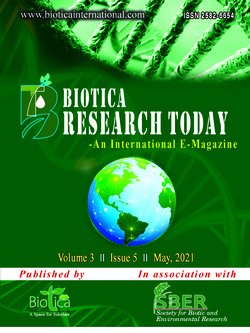
Biology and IPM Practices for Pod Fly in Pigeonpea
M. M. Deshmukh
Dept. of Agricultural Entomology, Vasantrao Naik Marathwada Krishi Vidyapeeth, Parbhani, Maharashtra (431 402), India
DOI: NIL
Keywords: Biology, Management, Pigeonpea, Pod fly
Abstract
Pigeonpea Cajanus cajan (L.) Millp. is an important pulse crop, which is widely cultivated throughout India. It is also known by names like arhar, red gram or tur, grown in Kharif season of tropics and sub-tropics. The pod fly, Melanagromyza obtusa Malloch (Diptera: Agromyzidae) is small black fly, lay eggs through the wall of young pod, and is of economic importance only in the larval stages and is the major pest in medium and long duration varieties. Partially matured pods are used for egg laying than the tender or fully matured pods. Pod fly being an internal feeder, lay eggs inside the immature pod. The eggs hatch and developing maggot feeds on the developing immature seeds by making tunnels and pupate. Thus making the seeds unfit for human consumption as well as seed purpose.
Downloads
not found
Reference
Sahoo, H.R., Parsai, S.K., Choudhari, R.K., 1991. Bio-efficacy and economics of certain insecticides against pod infesting pests of pigeonpea, Cajanuscajan. Indian Journal of Plant Protection 19(1), 37-41.
Shanower, T.G., Romeis, J., Minja, E.M., 1991. Insect pests of pigeonpea and their management. Annual Review of Entomology 44, 77-96.
